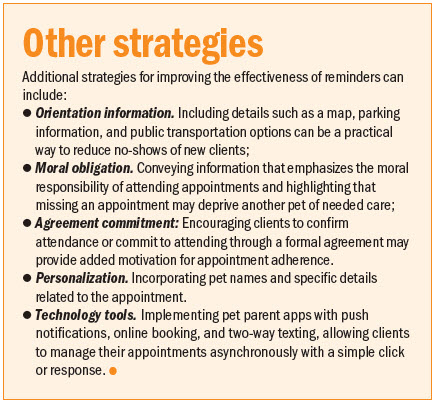
Numerous studies1 provide compelling evidence sending reminders is not only effective, but is also an expectation among clients.
Veterinary hospitals can utilize a variety of communication channels to reach pet owners—from postcards and phone calls to text messaging and mobile apps—and yet, the American Animal Hospital Association (AAHA) reports2 an industry-wide 11 percent no-show rate.
Consider a three-doctor practice where each veterinarian sees 20 patients per day with an average transaction of $200—an 11 percent no-show rate would translate into 1,716 missed appointments, and up to $343,200 lost revenue per year. In an attempt to fill this gap, hospitals may resort to overbooking, which could bring its own set of issues.
The main reason for missed appointments is simple: clients forget. In fact, research suggests3 the average human brain forgets 50 percent of information within an hour, 70 percent in 24 hours, and 90 percent in a week. Our brain is actually equipped with a separate set of mechanisms dedicated to active forgetting. So, how do we motivate the brain to qualify information as important and not erase it? Additionally, if it is not a matter of forgetfulness, but rather a lack of interest or willingness on the clients’ part to attend, how can hospitals encourage compliance?
The key might be found in the reminder content.
Studies below show making small adjustments to message phrasing and incorporating persuasive elements can enhance compliance. Even simple measures that reduce the effort required to take action–such as including a phone number in the message body or providing a one-button option to confirm, cancel, or reschedule–can significantly reduce the no-show rate.
Gain-framed and loss-framed reminders
One approach is the use of gain-framed and loss-framed reminders that focus on the psychological aspects influencing client behavior. Gain-framed reminders emphasize the positive aspects of attendance, linking it to improved well-being, while loss-framed reminders highlight the negative consequences of non-attendance.
The most commonly used reminder template consists of the time and date of the appointment (i.e. “Dear [Client name], this is a reminder you have an appointment with [Clinic name] on [date] at [time].”). However, including tangible benefits from attending, such as receiving valuable information, improving their pets’ well-being, or preventing more severe conditions, could substantially enhance the likelihood of the client showing up.
In one experiment in human healthcare,4 the researchers aimed to assess whether the inclusion of a health promotional message in the reminder would influence the reattendance rates of patients who missed their genitourinary medicine appointment. The participants were randomly assigned to three groups:
1) Control group (no intervention)
2) SMS notification of the defaulted appointment and an invitation to attend the clinic
3) SMS notification of the defaulted appointment, an invitation to attend the clinic, and a health promotional message about chlamydia
The results showed the reattendance rate was 4.5 percent in the control group, 8.2 percent in the group receiving a simple text reminder, and significantly higher at 15.2 percent in the group receiving a text reminder with a health promotional message.
Examples of gain-framed and loss-framed reminders for a pet dental appointment can be:
Gain-framed reminder
“Hi [Client first name], [Hospital name] here! This is a friendly reminder that it’s time for [Pet name]’s dental cleaning on [date] at [time]. Ensure their lasting happiness and health by confirming with a Y or use this link to reschedule: [link].”
Loss-framed reminder
“Hi [Client first name], a quick heads-up from [Hospital name]—don’t forget [Pet name]’s dental cleaning on [date] at [time]. Missing this important appointment could impact [Pet name]’s oral health. Please reply with Y to confirm or use this link to reschedule to maintain their well-being: [link].”
Money talks
Another interesting discovery comes from a study5 in the United Kingdom investigating the influence of rephrasing appointment reminders on “did not attend” (DNA) rates in human healthcare. Through experimentation with different persuasion approaches, the researchers uncovered adjusting the language of reminders can reduce missed attendance rates by around 25 percent.5
The experiment included the following types of messages:
- Specific costs. This message conveyed the specific financial cost incurred by the healthcare system when a patient misses their appointment. The aim was to make the financial impact of missed appointments more tangible and salient to the patients.
- Social norms. This message emphasized the societal norm of attending appointments by stating nine out of 10 people typically attend their scheduled appointments. It aimed to create a sense of conformity to a positive social norm.
- Easy call. This message included the telephone number in the body of the SMS reminder, making it more convenient for patients to cancel or reschedule their appointments. The goal was to reduce the effort required for patients to take a specific action.
- Empathy. This message reminded patients to consider the impact of their actions on others, particularly the potential delay in treatment for other patients waiting for appointments. It appealed to the individual’s sense of empathy and discouraged them from missing appointments.
- General costs. Similar to the specific costs message, it presented the concept of costs in more general terms. It communicated not attending appointments wastes National Health Service money without specifying a precise amount. The hypothesis was a more general message might be easier to adopt at scale, even though it might be less effective than a specific cost message.
- Recording. This message informed patients missed appointments would be recorded by the hospital. It highlighted the visibility of patients’ actions through data records and created a sense of accountability.
Data from two randomized trials5 showed the specific costs message was the most effective in lowering DNA rates compared to the other messages tested. Particularly, the rate of missed appointments was 8.4 percent with the specific costs message, compared to 11.1 percent with the existing message. The specific cost message was also more effective compared to the general costs message (8.2 percent vs. 9.9 percent).
Offering vs. recommending
One study6 examined whether healthcare providers’ explicit recommendations can influence vaccination rates. The trial included two messages delivered by the nurse at the end of an exam with subsequent follow-up reminders over eight months.
- Vaccine-offered message: “We have free hepatitis B virus vaccine available. Would you like to get vaccinated?”
- Vaccine-recommended message: “We have free hepatitis B virus vaccine available. I strongly recommend that you get vaccinated.”
Predictably, participants who received the vaccine-recommended message ended up getting significantly more vaccine doses than those who received the vaccine-offered message.
Relating this to pet care, clients could receive reminders about a vaccine booster in different ways. For instance, an offer-oriented reminder might say: “We have a special on vaccine boosters. Would you like to schedule an appointment?”
On the other hand, a recommendation-focused reminder could convey: “It’s time for your pet’s vaccine booster. We strongly recommend scheduling a visit to ensure their continued health.”
Such variations in message framing might influence the likelihood of pet owners taking action and scheduling and showing up for the necessary veterinary appointments for their pets.
In conclusion, various types of appointments may require different reminder wording and different persuasion techniques. Test diverse approaches to identify what resonates best with your clientele.
Sebastian Gabor is a serial entrepreneur, educator, and a firm believer in technology for the greater good. In 2018, he co-founded Digitail, an all-in-one cloud-based practice management software with a built-in AI assistant and a native pet parent ap. Email: sebastian@digitail.io.
References
- Kogan L, Schoenfeld R, Santi S. Medical Updates and Appointment Confirmations: Pet Owners’ Perceptions of Current Practices and Preferences. Front Vet Sci. 2019 Mar 20;6:80. doi: 10.3389/fvets.2019.00080. PMID: 30949487; PMCID: PMC6435479. Available at: https://www.ncbi.nlm.nih.gov/pmc/articles/PMC6435479/.
- Myers W. Four ways to help end the no-show crisis. Published February 8, 2022. Available at: https://www.veterinarypracticenews.com/bizbuilder-feb-2022/.
- Dr. Art Kohn Explains How to Achieve the Optimal Learning Experience with Boosts and Bursts. National Registry of CPE Sponsors. Published October 1, 2017. Available at: https://www.nasbaregistry.org/cpe-monitor-newsletters/dr-art-kohn-explains-how-to-achieve-the-optimal-learning-experience-with-boosts-and-bursts.
- McLean S, Gee M, Booth A, et al. Targeting the Use of Reminders and Notifications for Uptake by Populations (TURNUP): a systematic review and evidence synthesis. Southampton (UK): NIHR Journals Library; 2014 Oct. (Health Services and Delivery Research, No. 2.34.) Chapter 6, Discussion. Available at: https://www.ncbi.nlm.nih.gov/books/NBK260107/.
- Hallsworth M, Berry D, Sanders M, Sallis A, King D, Vlaev I, Darzi A. Stating Appointment Costs in SMS Reminders Reduces Missed Hospital Appointments: Findings from Two Randomised Controlled Trials. PLoS One. 2015 Sep 14;10(9):e0137306. doi: 10.1371/journal.pone.0137306. Erratum in: PLoS One. 2015;10(10):e0141461. PMID: 26366885; PMCID: PMC4569397. Available at https://www.ncbi.nlm.nih.gov/pmc/articles/PMC4569397/.
- Kasting ML, Head KJ, Cox D, Cox AD, Zimet GD. The effects of message framing and healthcare provider recommendation on adult hepatitis B vaccination: A randomized controlled trial. Prev Med. 2019 Oct;127:105798. doi: 10.1016/j.ypmed.2019.105798. Epub 2019 Aug 9. PMID: 31404569; PMCID: PMC6744972. Available at https://www.ncbi.nlm.nih.gov/pmc/articles/PMC6744972/.

